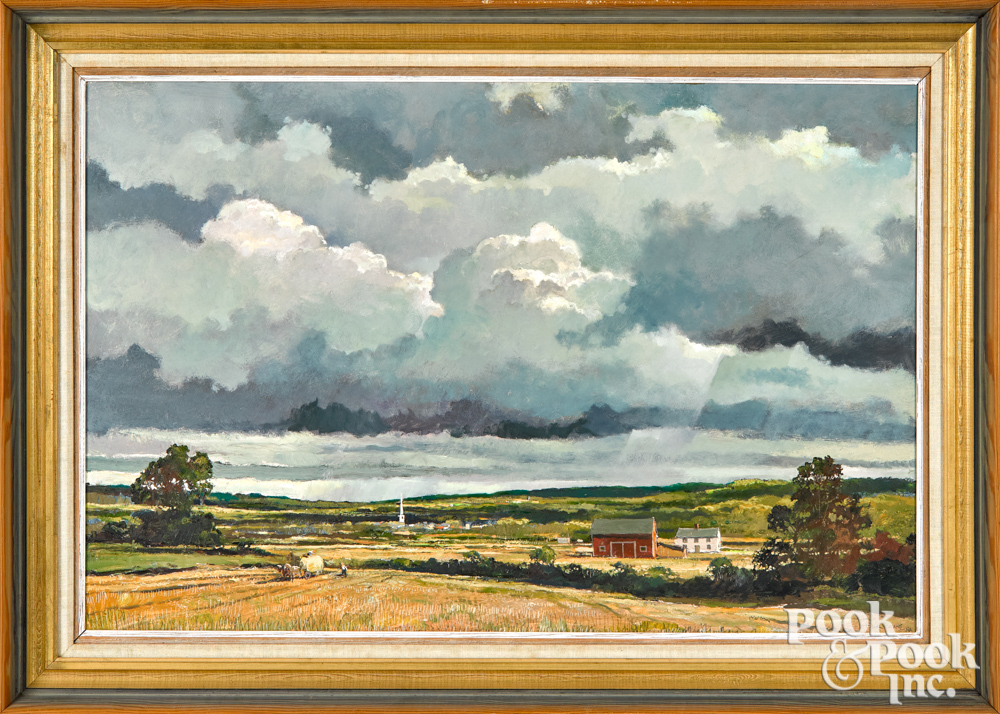Cloudscape
Cloudscape is a word coined by American artist and author Eric Sloane (1905-1985). His largest cloud painting is a 58 foot by 75 foot mural covering an entire wall of the Smithsonian Air and Space Museum.
In the 1920’s Sloane was hired to paint signs for Coney Island’s Steeplechase Amusement Park, which was being rebuilt after a fire. In exchange for painting hotel signs, he lived in the Half Moon Hotel, where he met guests to include the “Ashcan Eight,” and, because of the nearby Floyd Bennett Field, the great airmen of early aviation history. He studied with Robert Henri, George Luks, and John Sloan at the Art Students League and flew (and played poker) with aviation pioneers. His friend, pilot Wiley Post, once said “Someday, a fellow will come along and paint nothing but the sky itself.” This inspired Sloane to spend the next year doing exactly that. His first sale was a cloudscape in oil. It was bought by Amelia Earhart.
Lot 806, Eric Sloane oil on masonite landscape. Estimate $5,000-$8,000
Sloane decided to learn all he could about the weather and collected old farmer diaries and almanacs (finding kindred spirit Benjamin Franklin, whom he considered “possibly the greatest expert on weather”). Fascinated by the connection of early Americans to nature, he was romanced by their descriptions of “burdensome” stormy days, fair days “filled with life,” and the “thicke aire” of an approaching rain. He wrote his own weather manual, which was used by the Air Force for a wartime instruction pamphlet. He then attended M.I.T. but for him, the mathematics of meteorology lacked romance. His professor Sverre Petterssen was later to write the preface for his book Clouds, Air, and Wind: “Artists have striven for centuries to express nature in colors, forms, and symbols, but only rarely do we see the sky itself as an object of art. Eric Sloane is not primarily interested in mountains and meadows, castles and cattle, hills and horizons. His main interest is centered around the mountains of clouds, meadows of fog, hills of stratus, the skyscrapers of storm clouds, and the castles of air.”
From an old children’s magazine he learned to build a cloud catcher box. A box with a glass bottom painted black enables the artist to see the delicate coloring of the sky. The sky is full of color, but when looking right at it, sunlight blinds the eye. Sloane created a poem of grays. “The artist’s tricks come closest to being rules: he who can paint a sky with the least blue is the most capable artist. The blueness of sky is really an illusion, for air is colorless and space is black.” He used manganese blue, a bright, transparent cyan blue, as the only blue in his palette. In lot 806 of the October 1st , 2021 Americana & International auction at Pook & Pook, it is mixed with burnt sienna, forming cool, neutral grays. Sloane also used the cloud catcher box to better see shafts of sunlight and shadow in the sky, often referred to as “the sun drawing water,” and visible in lot 806. Weather expert Sloane enjoyed knowing that “the sun is always drawing water because heat always causes evaporation, so the shafts of shadow are really areas where the sun is not drawing water,” and, “Although the sun shafts might appear to spread out, they are always completely parallel because of the immeasurable distance of their light source.” (Sloane, Eric, For Spacious Skies)
Lot 806 is a summer hay harvest, probably August, in New England. Tiny figures are busy under a sky of climbing clouds. “On any hot afternoon after the sun-warmed earth has been heating the atmosphere since morning and there is “thunder in the air”, you can usually look to any western quadrant and see the darkness of cold-front clouds looming on the horizon… The cold-front thunderhead is most typical of the American summer…the front of an approaching cold air mass slopes downward in snowplow fashion, it plows up the warmer air into high cumulonimbus or vertical thunderhead clouds about every ten miles along the front.” (FSS)
Eric Sloane loved that American skies are different from any other. He insisted you could tell where you are in America by looking upward. ”The United States weather is controlled by six moving air masses and combinations thereof, a solution that daily baffles even the more expert weathermen. The effects of these mixtures produce Vermont skies, Florida thunderheads, New Mexico cloudscapes, and Maine fogs.” The winds swirling around pressure systems, clockwise around high and counterclockwise around low, has led to its own branch of Americana. “The most important weather sign of all is the direction and tendencies of the wind…The part that wind has played in our folklore gives it the right to be known as a phase of Americana. Only in America could the antique weather vane reach such importance. Not only a work of art, but an actual farm instrument…” (FSS)
Sloane loved impending rain: “Lowering air pressure releases gases and odors that stimulate animal sensitivity. It is natural to presume that humans, too react to pre-storm weather; at least they feel some sort of restlessness conducive to creativity… ideas are stimulated by the slight reduction of oxygen in his arteries, possibly to the extent of one good glass of wine.” (Sloane, Eric, Eighty)
Another Sloane signature present in lot 806 is the church steeple, which he viewed as the meeting of Heaven and Earth, or the finger of man pointing toward heaven. “Once when I bought the work of a famous Hudson River School painter, I felt the urge to forge such a touch. Later when I donated the piece to a museum, an art critic called attention to the distant church. “That faraway spire,” he wrote, “is the final touch of the painter’s rare genius.” I suppose I should have deleted the forgery before donating the painting but I’m sure the artist, who has long departed, would forgive me...” (Eighty)
Sloane believed we all carry within us some of the divine. He had a “happy accident” theory of painting: starting immediately with shapes of light and shade, applying “gobs of paint with a house-painting brush (as much as four inches wide). The result is that very frequently a cloud effect appears (completely by accident) which is created far beyond the possibilities of whatever talent I might have. The effect inspires the whole rest of my work.”(FSS)
Sloane worked from memory, as the sky he painted changed every few seconds. He regarded art as a kind of remembering, saying: “Very often the art buyer is not buying art as much as buying back a lost piece of his own life which to him is most valuable. We all have long-ago instants, forgotten memories, poignant moods, beautiful moments that we’d give anything to relive; only music or art can bring them back..”(FSS) In spite of this, Sloane deliberately never dated his own paintings. He lived very much in the moment, completely immersed in whatever he was doing, be it painting barns, collecting Americana, writing books, building a museum, meteorology, or studying the aesthetics of the atmosphere.
Sloane was not restrained by traditional painting practices. In 1924 a salesman gave sign painter Sloane samples of a new building material Masonite, which he immediately adopted for his paintings. He used it because “It is nearly indestructible… and can be sawed to size, like cropping a picture.” Sloane cut works down to proper composition dimensions. A four foot painting might end up half that size. “My first gold medal was won with a painting that I had sawed almost in half to fit the size requirements of the show. A saw is an important part of my studio equipment.”(80). Another maverick studio habit was his use of unleaded gasoline instead of turpentine. He liked that it dried quicker and disappeared completely, leaving pure oil paint behind. Sloane also utilized broken brush handles to scratch in grass patterns, many rags, razor blades, and pencils. Friend Andrew Wyeth was amazed by Sloane’s “unorthodox painting methods for creating textures and lines,” calling him “an Artistic Treasure of Americana.”(Wigley, Michael, Eric Sloane’s America, Forward by Mimi Sloane)
_____________________________________________
Browse Pook & Pook's Americana & International auctions coming up on September 30 and October 1, 2021.
By Pook & Pook Inc
Copyright © 1999 - 2025 Pook & Pook Inc. All Rights Reserved.
- Arts Foundation of Cape Cod Assembles Artwork From Top Artists for Its Annual Deck the Walls Auction
- WINTER AUCTION OF JEWELRY & TREASURES COMES TO TURNER AUCTIONS + APPRAISALS ON DECEMBER 13
- Rafael Osona Holiday Auction Features Fine Art, Jewelry & Maritime Works
- Post-Auction Press Release, Americana Auction, October 1,2,3, 2025 at Pook & Pook
- TURNER AUCTIONS + APPRAISALS PRESENTS THE GLADYNE K. MITCHELL COLLECTION ESTATE ON JULY 19
- Celebrate American Heritage with Dana Auctions’ January 25 Antique and Vintage Quilt and Textile Auction
- Exciting Online Auction from Rafael Osona Auctions - Exceptional offerings across multiple categories
- DIAMONDS ARE FOREVER: FINE JEWELRY, DIAMONDS & MORE COME TO TURNER AUCTIONS + APPRAISALS
- TAKE TIME OUT TO VIEW SPORTS MEMORABILIA, COMING TO TURNER AUCTIONS + APPRAISALS ON AUGUST 17
- Rafael Osona Announces Two Day Auction, Aug 3 & 4, 2024 Americana, Fine Arts, Historic Nantucket, Décor ~ Saturday, August 3 The Marine Session ~ Sunday, August 4 Open for Bidding ~ 1000 Lots ~
-
Antique Toy Auction at Pook & Pook Inc, with Noel Barrett
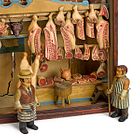
-
Sporting Immortality
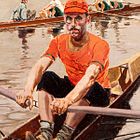
-
The Collection of Mrs. John Gutfreund – Murray House, Villanova, Pennsylvania
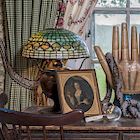
-
Leonora Carrington Oil Painting Sells for More Than Twice the Asking Price in the Latin American Art Auction Hosted by Morton Subastas in Mexico City
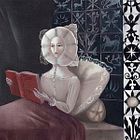
-
Peter Tillou Collection Highlights Litchfield Auctions’ 25th Anniversary
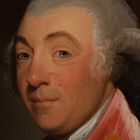



 EUR
EUR CAD
CAD AUD
AUD GBP
GBP MXN
MXN HKD
HKD CNY
CNY MYR
MYR SEK
SEK SGD
SGD CHF
CHF THB
THB
